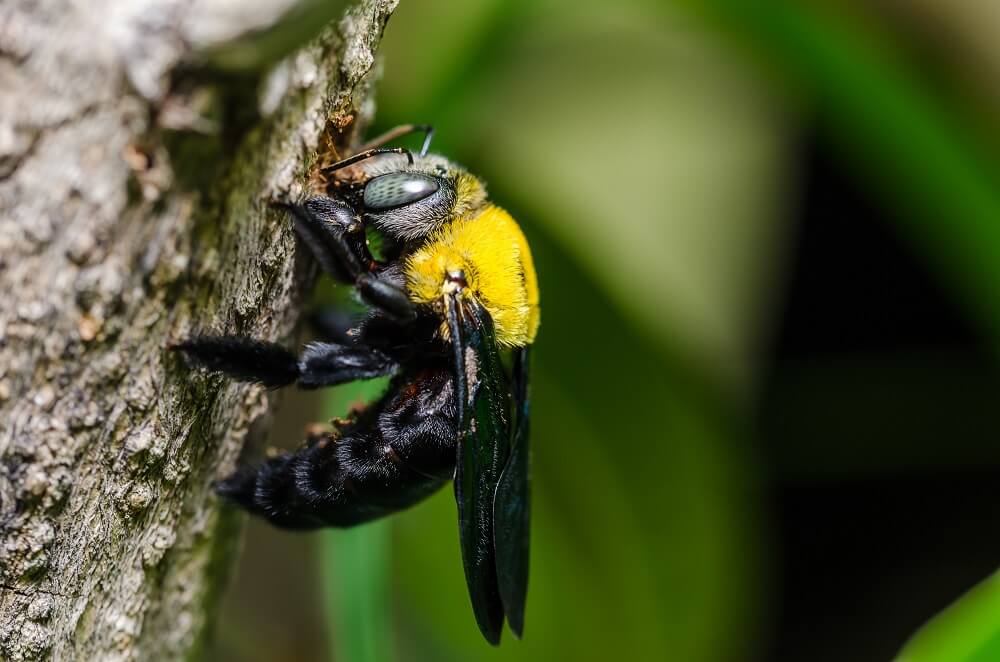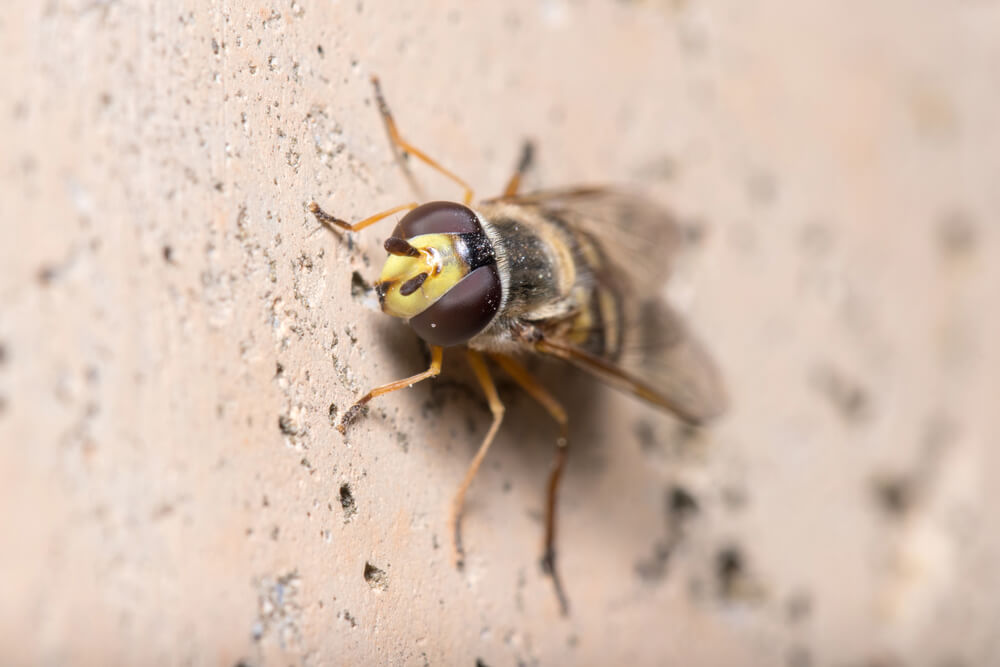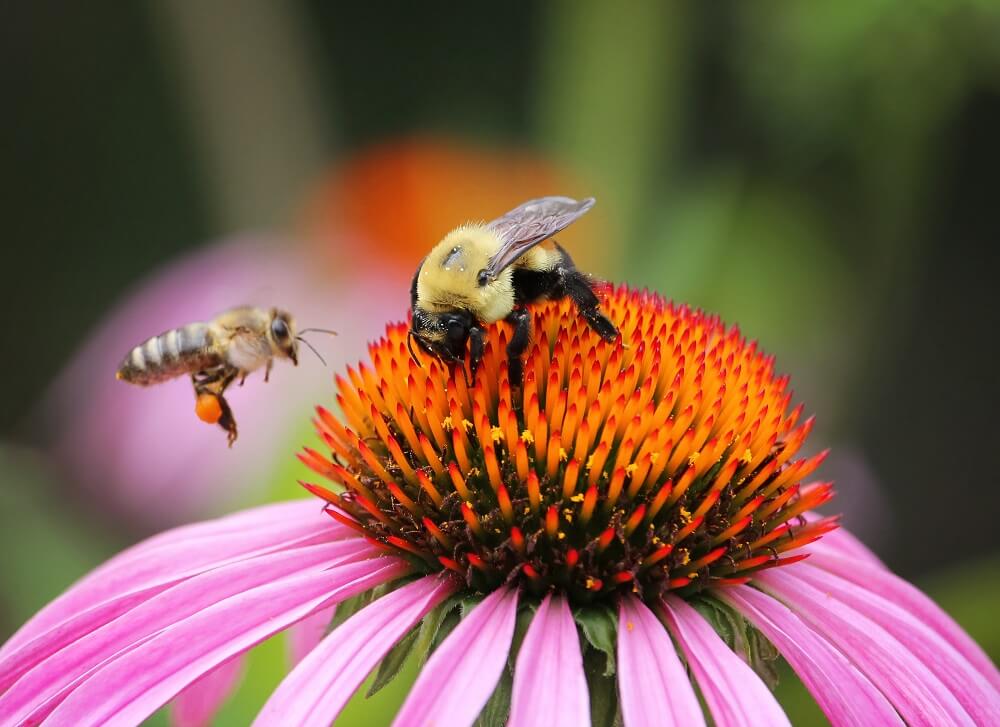In this article:
Do Carpenter Bees Sting?
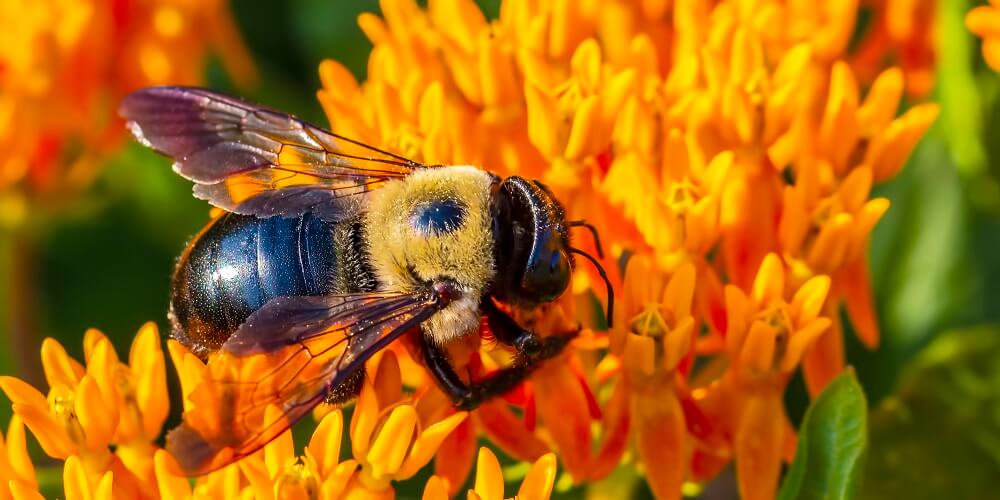
The simple answer is yes. Carpenter bees can sting, but it’s unlikely.
Now here’s the thing:
Female carpenter bees are the only carpenter bees that have stingers. Male carpenter bees do not.
But while female carpenter bees can sting you, they’re unlikely to do so unless you’re handling them or poking your fingers into their tunnels.
The golden rule is this:
If you leave bees alone, they’ll leave you alone.
Even if you try to shoo carpenter bees away, they may fly closer to you, but they typically won’t sting you unless you’re close to their nest.
And here’s the deal:
It’s more common to encounter a male carpenter bee (without stingers) than a female carpenter bee (with stingers).
Why?
Because male carpenter bees hover outside their burrows to protect their nests. Female carpenter bees, on the other hand, are busy inside the nest tending to their larvae.
The male carpenter bee may buzz around you if you get too close, but it won’t sting you since the males don’t have stingers.
Now you’re probably thinking:
Well, how do I get rid of carpenter bees? I don’t want them causing damage to my property.
Good question.
First, we have to address the elephant in the room.
Related: Do Carpenter Bees Pollinate?
The One Thing You Should Know About Carpenter Bees
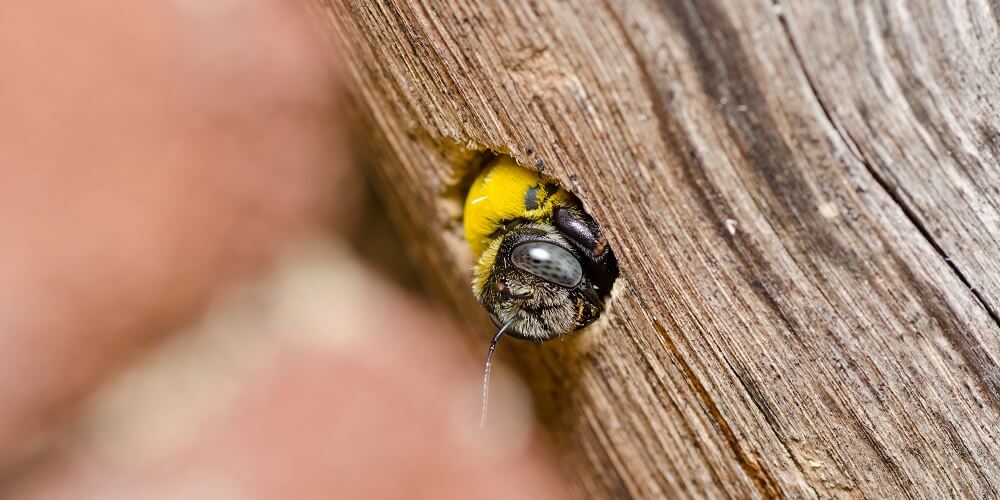
As pollinators, bees are a crucial part of the circle of life. In fact, bees are responsible for one in every three bites of food we eat.(1)
And to take it a step further?
Over 75% of flowering plants require pollinators to survive.(2)
So let me ask you:
Have you had a cup of coffee lately?
You can thank a bee for that.
Have you eaten chocolate lately?
Thank a bee.
And what about fruit like apples or oranges?
You guessed it.
You can thank a bee for those too.
So the one thing you should know about bees is this:
All types of bees – including carpenter bees – are essential to our food supply. Without them, our gardens would be sparse and our plates empty.
So when it comes to removing carpenter bees from your property, remember that you can do so without harming them. Spraying citrus oil around the holes and using decoy wasp nests to scare them away will do the trick.
Now that brings me to our next point…
How to Treat Carpenter Bee Stings

Here’s a fun fact about carpenter bees:
Unlike honeybees, carpenter bees don’t die after stinging. This allows them to sting several times if needed.
With that in mind, how do you treat carpenter bee stings?
For starters, clean the area with soap and water.
Next, ice the sting site to decrease venom absorption and reduce swelling. Ice should be applied for 20 minutes every hour, as needed. To prevent the skin from freezing, wrap the ice in a towel.
Hydrocortisone cream can also be applied to the sting to relieve redness, itching, and swelling.(3)
You can also treat carpenter bee stings with home remedies, including:(4)
- Baking soda – Apply baking soda paste (baking soda mixed with water) to the affected area. Cover the paste with a bandage and leave it on for at least 15 minutes before removing it.
- Honey – Apply a little amount of honey to the wounded region. Cover with a loosely tied bandage and leave on for up to an hour.
- Apple cider vinegar – Soak a bandage or cloth in apple cider vinegar and apply it to the stinger area for at least 15 minutes.
- Toothpaste – Dab a little toothpaste on the afflicted region and leave it on until the discomfort subsides.
The good news is that you can use these methods to treat most bee stings at home.
That is unless you’re allergic to bees or have indications of a severe allergic reaction. An allergic reaction can be a medical emergency that requires treatment.
Signs of an allergic reaction might cause:
- Severe itching
- Hives
- Swelling of the mouth
- Difficulty breathing
- Dizziness
- Pale skin
If a severe reaction begins happening to you, then someone should contact emergency medical services immediately.
Related: How to Get Rid of Carpenter Bees
What is a Carpenter Bee, Anyway?
Carpenter bees are the United States’ largest native bee. These bees are considered “gentle giants” because of their friendly and calm nature. You might also hear carpenter bees referred to as “wood bees.”
Carpenter bees get their name because they build their nests inside of wood. They use their broad, strong jaws to chew into wood and create perfect circles.
But here’s the thing:
Carpenter bees don’t actually eat wood.
Like other bees, they eat pollen and plant nectar from flowers. This means they’re important pollinators for our ecosystem, which is why it’s important to repel carpenter bees naturally instead of harming them.
Now you might be asking:
Are bumblebees and carpenter bees the same?
No.
Carpenter bees resemble bumblebees but they’re totally different species. (Read our article on, “Do bumble bees sting?” for more information).
Here’s a side by side comparison:
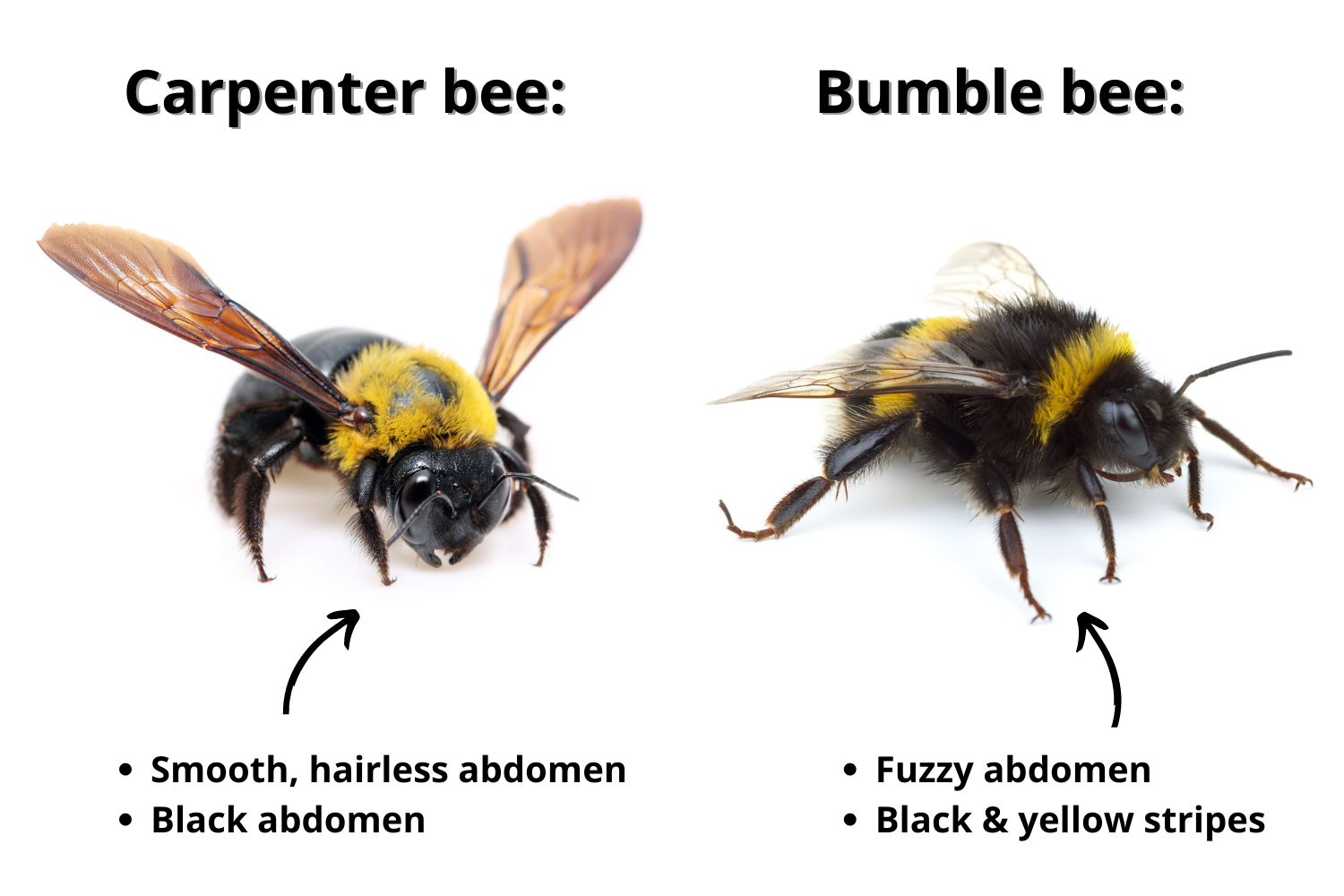
Carpenter bees and bumblebees have different nesting habits as well. Bumblebees nest mostly underground, whereas carpenter bees dig holes into wood to lay their eggs.
If you spot a few bees around the eaves of your porch, it’s likely carpenter bees. You’ll also notice tiny indentations where they chew the wood to create a burrow.
Carpenter bees’ nests are easy to spot since they drill perfectly circular half-inch holes, usually against the grain of the wood. They love to create homes in windowsills, doors, wood railings, telephone poles, and even wooden outdoor furniture.
Unfortunately, their nests can cause significant damage to wood structures over time.
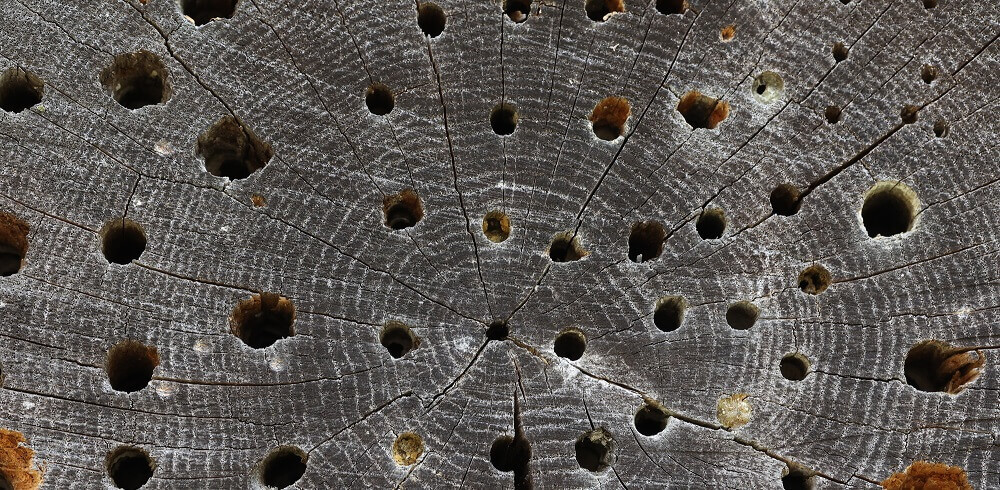
So now the question becomes…
How do I Remove Carpenter Bees Without Hurting Them?
There are several ways to deal with carpenter bee infestations, including insecticides (which aren’t safe for kids) or professional exterminators (who charge a lot of money).
However, there is a much safer solution that doesn’t involve any chemicals – simply use these tips for removing carpenter bees naturally:
1. Use essential oils to repel carpenter bees
One way to deter carpenter bees is to use a citrus oil repellent. You can mix some citrus essential oil with water in a spray bottle. Or, you can make your own repellent by boiling citrus fruit in water for 10-15 minutes.
Once you have your solution, you’ll spray it around the bee holes and other areas you want to protect. Don’t spray it inside the bee holes, as we don’t want to hurt the carpenter bees. We just want to deter them.
Carpenter bees also don’t like peppermint, tea tree, or almond oil. You can spray these oils around the holes to encourage them to leave.
2. Play loud music near their burrows
Carpenter bees can be eliminated relatively easily by using loud noises and vibrations to repel them. Bees are hypersensitive to high frequencies.
So how do you do it?
Start by playing loud music near the area of the infestation for 2-3 days. The sound will disturb the bees and cause them to leave the nest.
3. Hire a professional pest controller
As a last resort, you can hire a pro if you don’t want to do it yourself.
Many professional exterminators can get the bees to leave without harming them. This is the method we prefer since carpenter bees are pollinators that are a crucial part of our ecosystem.
Some exterminators can also seal the bee holes, preventing them from returning to your home.
Related: How Long Do Bumble Bees Live?
How to Prevent Carpenter Bees From Coming Back
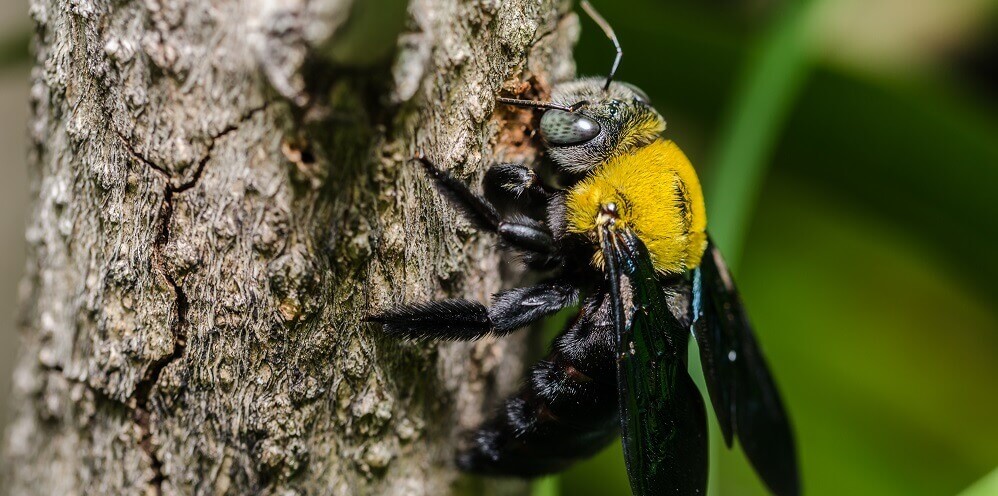
Once you’ve got the carpenter bees to leave, you want to keep your home free and clear. Here are a few tips to prevent them from coming back:
- Locate the holes. Examine your property for spots where bees (and other insects!) may enter.
- Fill in any holes. It’s always a good idea to fill holes with something that will last, such as plugs, caulk, or putty. Plugging holes during the fall is best because the bees aren’t active. Bees will build new tunnels and continue to damage your property if you plug holes while they’re inside. Remember that bees will reuse old gaps the next season, so make sure to close them.
- Add a finish. The greatest and most effective approach to prevent carpenter bees from damaging your home is to add a coat of paint or another finish to the wood. Bees are attracted to unfinished wood.
- Use decoy wasp nests. Carpenter bees don’t like to nest in areas with wasps. If you hang a few fake wasp nests like these, you’ll increase your chances of keeping carpenter bees away.
FAQS About Carpenter Bees & Carpenter Bee Stings
- Do carpenter bees eat wood?
- Are carpenter bees pollinators?
- What are the signs of carpenter bees around my home?
- Do carpenter bee stings hurt?
- Are carpenter bees friendly?
- Why do carpenter bees chase me?
- Are bumblebees and carpenter bees the same?
- Do carpenter bees keep wasps away?
- How do you tell if a carpenter bee is male or female?
- What smell do carpenter bees hate?
- What is the lifespan of carpenter bees?
- Do carpenter bees sting dogs?
- Do carpenter bees make honey?
- Do carpenter bees sting and die?
Do carpenter bees eat wood?
No, they don’t. The wood damage they cause comes from tunneling into the wood to build nests.
So now you’re thinking:
Well, what do carpenter bees actually eat then?
Good question.
Like all other bees, they eat nectar and pollen. This makes carpenter bees pollinators, and that’s why we don’t want them to disappear. They pollinate food crops and plants which humans rely on. This is why you should deter carpenter bees naturally.
—> Go back to the “Do carpenter bees sting?” FAQs
More to Explore:
- Are Wood Bees Harmful?
- Are Carpenter Bee Stings Dangerous?
- How to Remove a Bee Stinger Stuck Under Skin
Are carpenter bees pollinators?
Yes, carpenter bees are incredible native pollinators that play an important role in our ecosystem. Carpenter bees pollinate flowers, feed birds, and increase the yield of certain plants.
More specifically?
Around 15% of crops are pollinated by native bees like carpenter bees.(5)
That’s why it’s important to deter them without using carpenter bee traps. This is a win-win because it ensures the safety of your home while also preserving these wonderful bees.
You can make your own carpenter bee spray to repel them. Carpenter bees don’t like the smell of citrus oil, peppermint oil, tea tree oil, or almond oil. If you spray one of these scents around their burrows, they’ll leave.
—> Go back to the “Do carpenter bees sting?” FAQs
More to Explore:
What are the signs of carpenter bees around my home?
The most apparent sign that you have a carpenter bee problem are holes drilled into the wood on the exterior of your property. It’s also possible that you’ll notice sawdust on the ground beneath the drilled hole. Inside the holes, you may notice a yellow coating which is pollen.
Also, male carpenter bees often buzz loudly near the entrance to their burrow.
—> Go back to the “Do carpenter bees sting?” FAQs
More to Explore:
Do carpenter bee stings hurt?
Like other types of bee stings, a carpenter bee sting is unpleasant but not unbearable for most. That said, carpenter bees can sting more than once, making being stung somewhat more worrisome.
The good news?
A carpenter bee sting can usually be treated at home, and symptoms will disappear in a day or two.
—> Go back to the “Do carpenter bees sting?” FAQs
More to Explore:
Are carpenter bees friendly?
“How aggressive are carpenter bees?” is a common question we get.
The answer?
In a nutshell, carpenter bees are considered friendly bees. Some people call them “gentle giants” because of their calm nature.
Remember:
The males don’t sting because they don’t have a stinger. The females have a stinger and can sting, but it’s very rare.
—> Go back to the “Do carpenter bees sting?” FAQs
More to Explore:
Why do carpenter bees chase me?
Carpenter bees are territorial when it comes to their nest. This is why they may buzz around you if you get too close to their burrows. A male carpenter bee’s main objective is to deter other insects or pests.
So essentially, the male carpenter bee’s movement around people or pets is an attempt to flex his muscles and assess the risks in his environment.
—> Go back to the “Do carpenter bees sting?” FAQs
More to Explore:
Are bumblebees and carpenter bees the same?
No.
Carpenter bees and bumblebees are two separate species with distinct appearances, habits, and lifecycles.
Bumblebees are members of the genus Bombus, with about 250 different species. Carpenter bees belong to the genus Xylocopa, which has roughly 500 species in this group.(6)
That said, bumblebees and carpenter bees can look alike which leads to confusion about which is which.
—> Go back to the “Do carpenter bees sting?” FAQs
More to Explore:
Do carpenter bees keep wasps away?
Typically it’s the opposite. Carpenter bees will avoid nesting in the same location as wasps.
—> Go back to the “Do carpenter bees sting?” FAQs
More to Explore:
How do you tell if a carpenter bee is male or female?
The male and female bees are physically very similar. The most significant distinction is the markings on their heads. Male carpenter bees have little white markings on their head, but the females have entirely black heads.
—> Go back to the “Do carpenter bees sting?” FAQs
More to Explore:
What smell do carpenter bees hate?
The scent of citrus repels carpenter bees naturally without harming them. So if you’re wondering, “How do I get rid of carpenter bees without killing them?” this is how:
Spray citrus oil around freshly drilled or existing holes to deter carpenter bees from building a nest there. You can also wipe down areas that the bees are attracted to with the oil directly.
—> Go back to the “Do carpenter bees sting?” FAQs
More to Explore:
What is the lifespan of carpenter bees?
Female carpenter bees can live for up to three years, and there may be one or two new generations born per year. Male carpenter bees typically live up to one year.
—> Go back to the “Do carpenter bees sting?” FAQs
More to Explore:
- Ground Bees: Are They Harmful to Your Yard?
- How Many Legs Do Bees Have?
- Are Worker Bees Male or Female?
Do carpenter bees sting dogs?
This is a common question we get, along with other questions like:
Do female carpenter bees sting?
Do male carpenter bees sting?
Do carpenter bees sting or bite?
Do carpenter bees hurt humans?
The answer is that it’s possible that female carpenter bees can sting dogs, but it’s highly unlikely. It should be fine as long as the dog isn’t poking around the nest and making the bees feel threatened.
—> Go back to the “Do carpenter bees sting?” FAQs
More to Explore:
Do carpenter bees make honey?
No. Unlike honeybees, carpenter bees don’t hang out in a hive and don’t produce honey or honeycomb.
—> Go back to the “Do carpenter bees sting?” FAQs
More to Explore:
- How to Keep Bees Away From Hummingbird Feeders
- How Long Do Bees Live?
- Wasp vs. Honeybees: How Do They Compare?
Do carpenter bees sting and die?
No.
Carpenter bees have smooth stingers that they can use multiple times without dying. Fortunately, carpenter bees are passive in nature.
In contrast, stinging is deadly for honeybees. The reason is that honeybees, unlike other bees, have barbed stingers. The stinger is left behind when the honeybee flies away, effectively disemboweling it and causing it to die.
Read our article, “Do honey bees sting?” for more information.
